Originally published May 2022. Updated November 2023.
Do you want to eat less meat and more plants? Are you unsure how to start?
There is a lot to navigate. What foods can you eat? Will you miss out on key nutrients? What’s the best way to get started?
I’m Christianna Gozzi, plant forward dietitian. I totally get it because I’ve been there myself.
That’s why I wrote this essential guide to the Plant Forward Diet. I will explain what a plant-forward diet is (and what it is not), the health and nutrition benefits of eating more plants, and essential tips for how to get started on a plant forward diet.

Table of Contents
What is the plant-forward diet?
The plant forward diet is a style of eating that emphasizes plant-based foods like vegetables and fruits, plant-based proteins, whole grains, nuts and seeds, herbs and spices and plant oils without necessarily eliminating animal products.
The plant-forward movement is an overarching food and nutrition philosophy that draws upon the science, knowledge, and culinary practices from the larger plant-based diet movement.
People are drawn to the plant-forward approach because they want to eat more plants and less meat in fun, flexible, environmentally conscientious, nutritionally balanced and culturally inclusive ways.
How does plant-forward differ from other plant-based diets?
All plant-based diets, plant-forward included, are made up of primarily plant-based foods. Plant-forward differs from other plant-based diets because it allows for meat in small quantities relative to plants.
What does plant-based mean?
Plant-based foods are defined by the US Department of Agriculture (USDA) as “foods originating from plant sources.” This could be a single raw ingredient like a strawberry or a plant-based burger made with a bunch of ingredients.
Fruits and vegetables, grain-based foods, beans and legumes, tofu and tempeh, nuts and seeds, and herbs and spices are all examples of plant-based foods.
While the term “plant-based diet” is used differently by different people, I find that many people who say they are “following a plant-based diet” mean that they are eliminating animal products from their diet.
It is helpful to understand the various types of popular plant-based diets. So let me break it down for you!
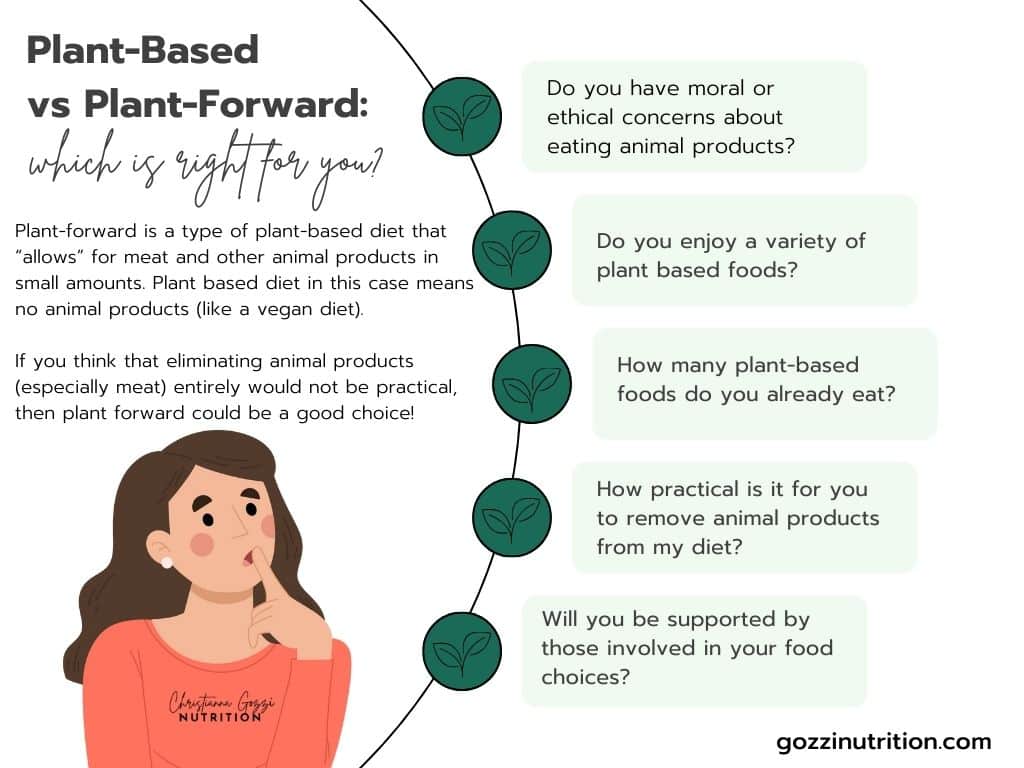
Vegetarian vs vegan diets
A vegetarian is defined by the USDA as someone who does not eat poultry, seafood, beef, pork or any other animal meats. Many vegetarians also do not eat products containing animal-derived food additives like gelatin, collagen and rennin.
Dairy foods and eggs may be included in a vegetarian diet. Lacto-ovo vegetarians may include dairy (cheese and milk) and eggs into their diet. Lacto-vegetarians may include dairy but no eggs. Ovo-vegetarians may include eggs but no milk or cheese.
Mostly-vegetarian diets include pescetarian (vegetarian + fish) and Mediterranean (vegetarian + fish + meat in small amounts).
A vegan diet is a type of vegetarian diet that restricts the consumption of animal products in all forms. This includes animal-derived food additives, dairy products, eggs and honey. Veganism often extends to items beyond food like beauty products, cosmetics and furniture.
Whole foods, plant based (WFPB) is a mostly vegan diet that restricts “processed foods.”
What do you eat on the plant-forward diet?
You guessed it! A lot of plants and moderate amounts of animal products. Let’s do a deep dive into plant-based foods.
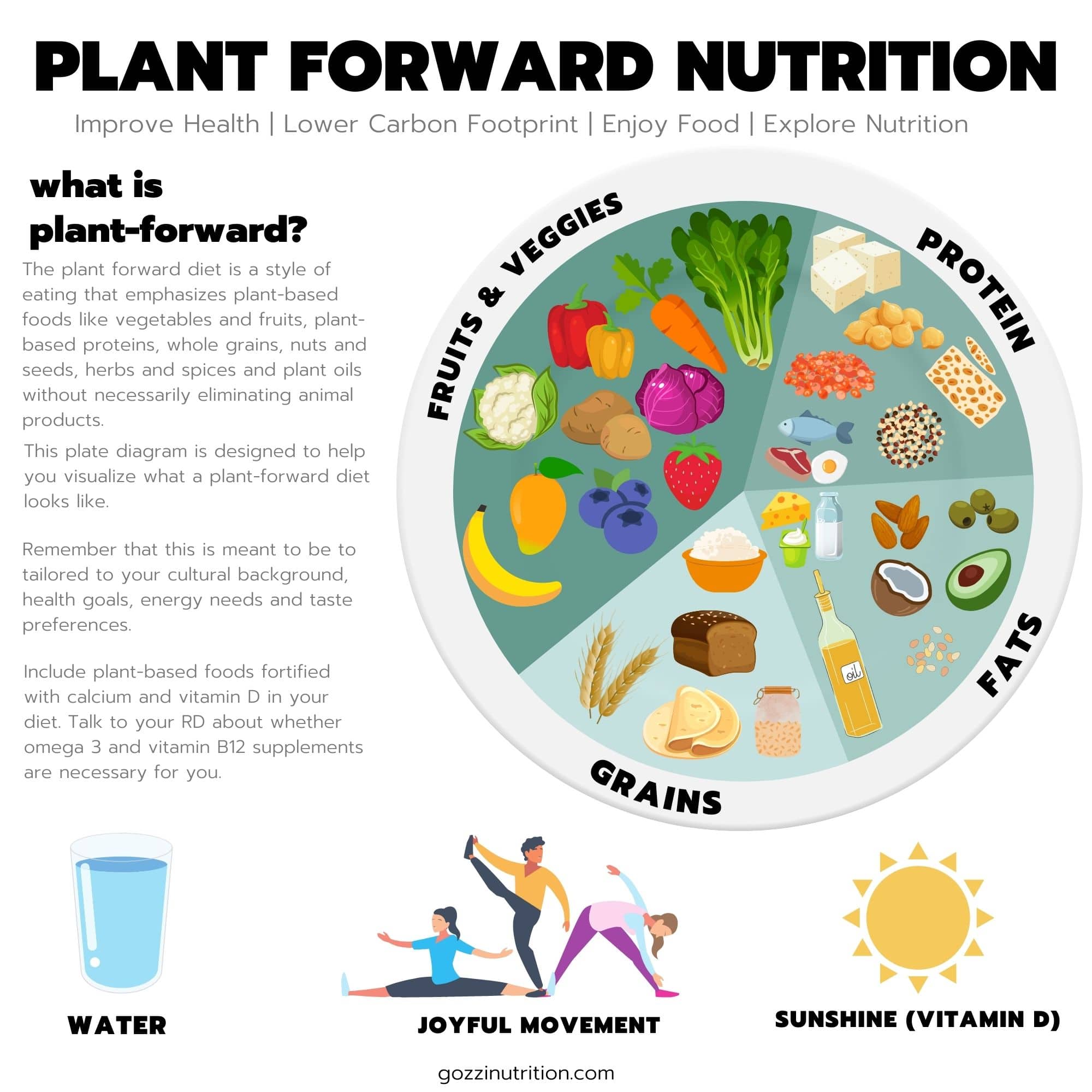
Vegetables and fruit
Plant-forward eaters enjoy fruits and vegetables in all their forms. If there is any “must be” in this diet, I would say it is that you must enjoy fruits and veggies!
The emphasis is on adding a rainbow of color to your plate. The bright colors of fruits and vegetables are actually nutritious pigments with a variety of health benefits.
Plant-forward cooks prepare fruits and vegetables in a variety of ways to play up texture and flavor including raw, roasting, blanching, stir-frying, air-frying, baking and sauteing. All forms of fruits and vegetables; fresh, frozen, packaged and dried, are used in the plant-forward kitchen.
Herbs and spices also play a prominent role in the plant-forward kitchen. They add tons of flavor without added salt and offer a wide range of antioxidant benefits.
Plant-based proteins
Soy-based proteins, like tofu and tempeh are probably the plant-based proteins you are most familiar with. Tofu and tempeh are commonly used in stir-frys, burgers and served alongside vegetables and grains in sheet pan meals and grain bowls.
Beans and legumes, like chickpeas, lentils, and black beans, are the main ingredients in many plant-based meals like tacos, burgers, and processed into a variety of convenience products like pasta, chips, faux meats and even cereal.
Plant-based protein is also found in grains like quinoa, amaranth, millet and wheat gluten. These grains are often used in salads, faux meat products and at breakfast time for a filling plant-based meal.
My article on High Protein Vegan Snacks is a great way to try new plant based protein recipes from dietitians.
Wholesome grains
Grains provide carbohydrates, fiber, antioxidants, vitamins and minerals to our diet. Plant-forward eaters include grains in their diet on a daily basis. Some examples include oatmeal bowls with breakfast, grain bowls for lunch and pasta with lentils for dinner.
It is fun to add a variety of grains in our diet because they have different flavors and textures. Some of my favorite grains include:
- Sorghum
- Farro
- Bulgur
- Popcorn (yes, popcorn is a whole grain!)
- Jasmine rice
Plant-based fats
Fat is an important part of our diet. We’ll talk more about getting enough omega-3 fatty acids on a plant-forward diet in the nutrition section of this article. Examples of plant-based fat sources include:
- Nuts and seeds (also a source of protein, fiber and minerals)
- Avocado and coconut-based products
- Plant based oils like olive oil, vegetable oil, algae oil and flaxseed oil
- Plant-based dairy products like butter, milk and cheese (usually made from soy, nut or coconut milks)
Meat and dairy products
One of my favorite things about the plant-forward diet is that you don’t have to completely eliminate animal products. You can choose to consume them for added nutritional value, cultural reasons and flavor boosting in cooking. If you include animal products, I recommend that you prioritize seafood.
Seafood contains vitamin D and omega-3s which are not as abundantly found in plant-based foods. Eating seafood two times a week supports brain development, mental health and heart health.
Many plant-forward eaters may regularly consume dairy and eggs in smaller quantities than plant-based foods. Eggs offer a wide variety of nutrition. It also can be fun to explore the plant-based dairy section. The key is trying a variety of options to find what satisfies you.
Plant-based Grocery List
The best way to identify a plant-based food is to look at the ingredient list. If it contains only plants, then you know the product is likely 100% plant-based–or at least plant-based enough for someone following a plant-forward style of eating.
There are third party verification stickers that you will be seeing more of. These include “certified plant-based” and “certified vegan.” Essentially, they signify to the consumer that the product contains no animal products.
I still recommend reading the ingredient label and nutrition facts panel over relying on these stickers. I teach you how to do this in my nutrition coaching program.
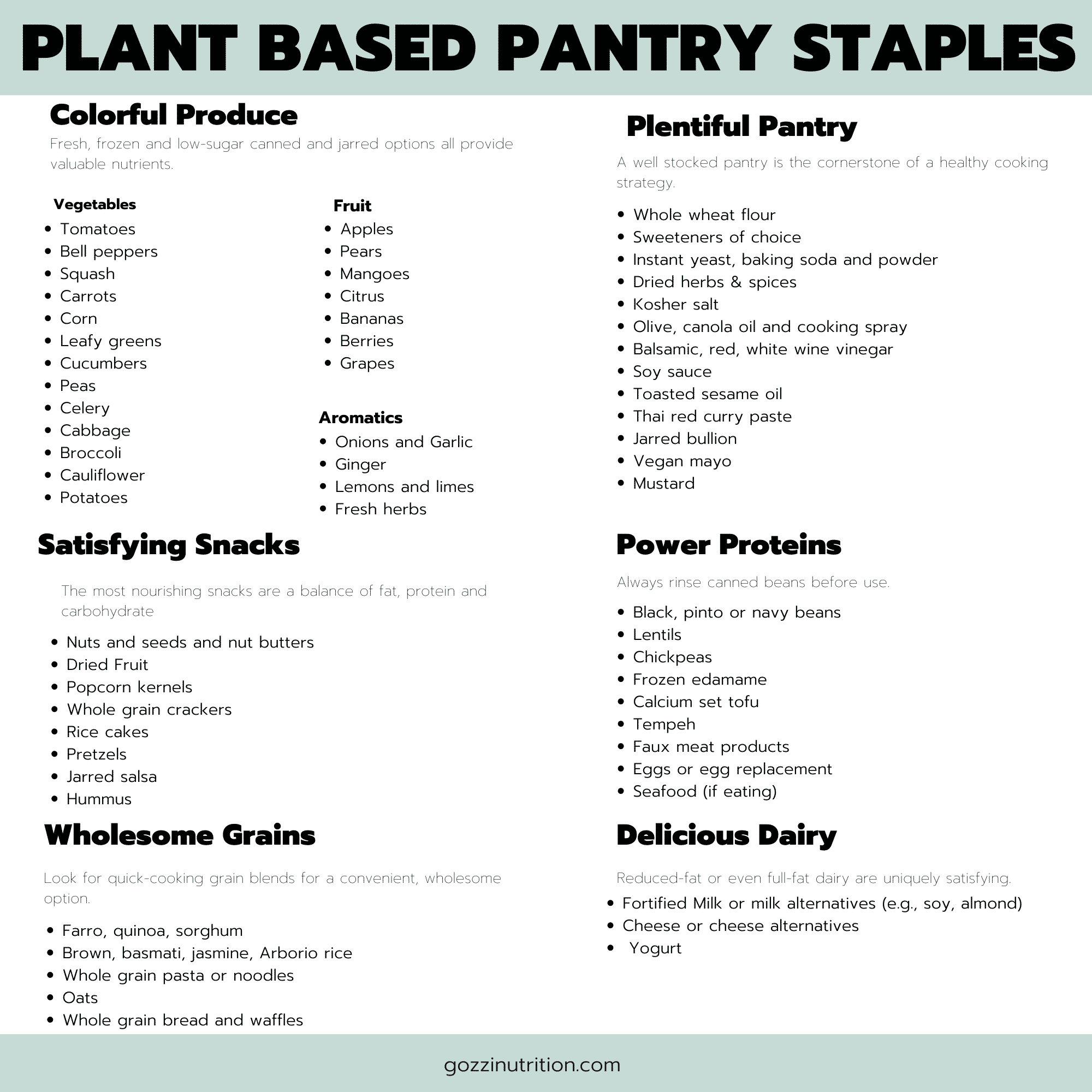
Plant Forward Meal Ideas
There are so many mouth-watering plant-based meal ideas out there. I have a database of plant-based recipes specifically curated for you in my nutrition coaching program. In the meantime, here is some advice on building balanced plant-based meals.
The swap + add method
When people are just starting to switch to a plant-based diet, I show them the “swap + add” method because it helps them visualize what they could actually be eating. The swap + add method is centered around the question, what can I add to this meal to make it more plant-based? What can I swap out of this meal to make more plant-based?
Before I give you some examples, here are some things to keep in mind when using the swap + add method. The swap + add method is only useful if the swap or add makes the dish equally or more enjoyable than its meat-based original. Please don’t go swapping and adding plants into your grandma’s treasured recipes.
Breakfast ideas:
Swap cow’s milk for soy milk. Add frozen fruit, nuts and seeds.
Swap white bread for whole wheat bread. Add nut butters and fruit, or mashed beans, avocado and veggies.
Swap eggs for scrambled tofu. Add beans and veggies to scrambles. Serve with fruit.
Lunch ideas:
Swap mashed chickpeas for egg or tuna salad. Add whole grain bread, spinach and sliced tomato.
Swap quinoa, tofu, beans or nuts for chicken in salads. Add whole grains roasted veggies, and an herb-based sauce.
Swap tempeh bacon for regular bacon on a BLT. Add avocado and vegan mayo or a plant-based bean spread.
Dinner ideas:
Swap plant-based meat for ground meat in meatballs and burgers. Add a green salad on the side with light vinaigrette.
Swap crispy tofu for chicken in stir-fries. Add edamame, colorful veggies and a dash of toasted sesame seeds.
Swap all-meat chili for three-bean chili or half-meat, half-bean chili. Add diced avocado and serve over a baked potato.
Want more? Check out these plant forward recipes for inspiration.
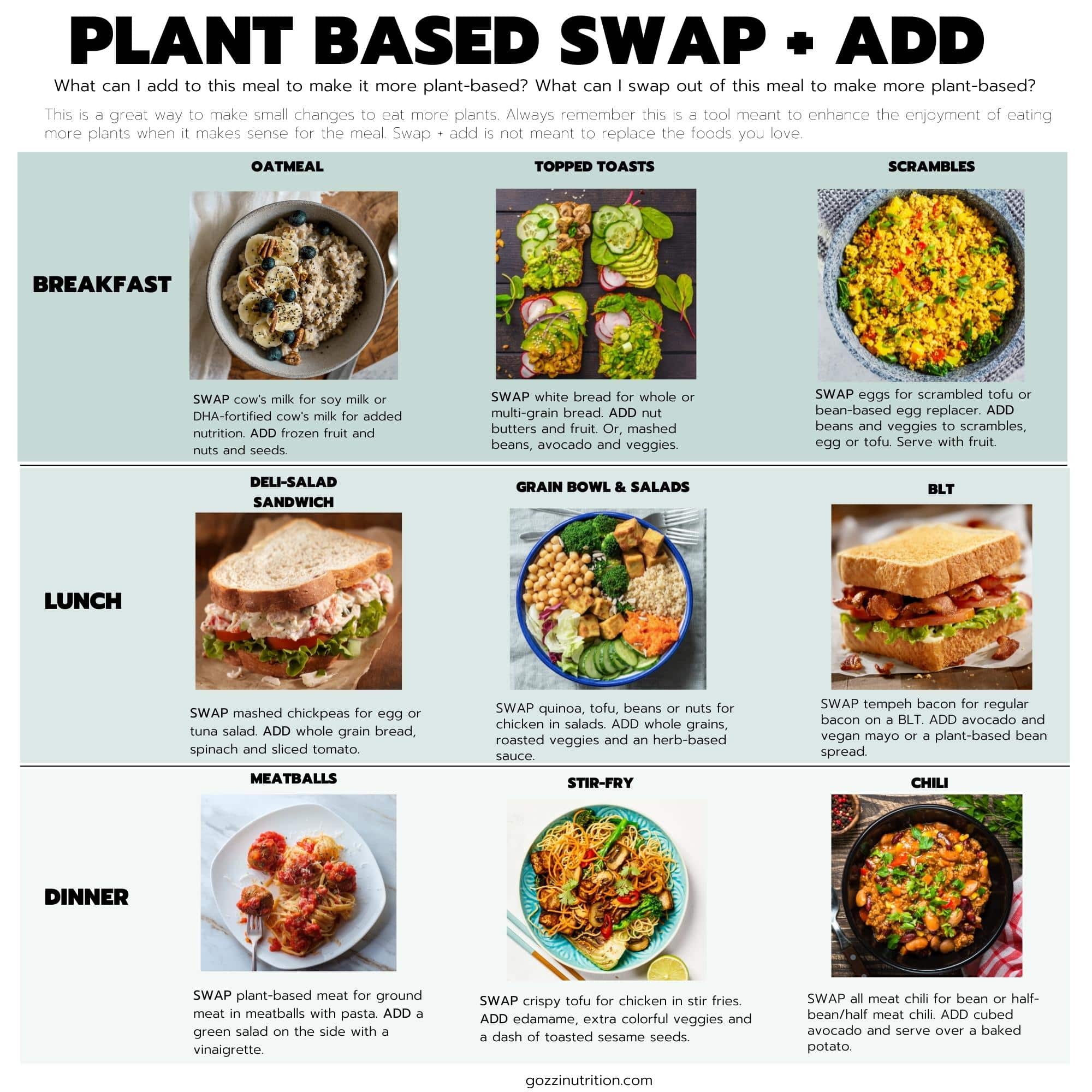
Why would I want to follow a plant-forward diet?
Reason 1: to improve your overall health
You probably already know that eating fruits and vegetables is good for you. Maybe you just want to “stack the deck” for disease prevention and overall health and wellness. Or maybe you’ve been diagnosed with a chronic disease and want to add more plants into your diet to meet your goals.
Either way, there are some great health-related reasons to eat more plants!
Live longer: No, eating your veggies is not a silver bullet for longevity. But, eating the recommended serving of plants, like fruits, vegetables and nuts may actually help lower your risk of mortality (death) (1).
Stay heart healthy: you may be able to protect your heart by feeding it more fruits, vegetables, whole grains and beans, nuts and seeds. Why? Because the fiber and antioxidants in these plant-based foods promotes heart health (2).
Reduce risk for cancer: the various compounds in plants may actually reduce our risk for developing certain cancers.The compounds called glucosinolates in cruciferous vegetables and dark leafy greens, like broccoli, brussel sprouts, and collard greens, are good examples (3).
Make the digestive tract happy: The good bacteria in our gut loves the fiber that comes from plants. This good bacteria may help our gut function at optimal levels. Optimal gut health is important for the treatment of chronic disease like IBS and prevention of heart disease (4).
Supports strong immunity: eating plants contributes to a healthy gut. A healthy gut actually supports a strong immune system. The vitamins and minerals found abundantly in plants are key to a healthy immune system largely because of anti-inflammatory properties (4; 5).
Reduces risk for vision loss: Antioxidant forms of vitamin A, lutein and zeaxanthin, are known to have a protective effect against macular degeneration (age-related eye disease that causes loss of vision). Leafy greens and corn are examples of foods that contain these compounds (6).
Boost brain function: plant-based foods, like berries, grapes and cocoa powder are rich in flavonoids. Flavonoids are compounds in food that may actually protect us from cognitive decline. Vitamin C also keeps our brains cells safe by acting as an antioxidant in the brain (7)
Reason 2: to reduce your carbon footprint
A 2021 International Food Information Council report revealed that 4 in 10 consumers consider the manufacturer’s commitment to a reduction in carbon footprint an important factor in food purchasing decisions (8). You may be one of those people!
Your carbon footprint is the amount of greenhouse gasses (carbon and methane) your actions produce. These greenhouse gasses contribute to climate change which is not good for the health of the planet (9).
Raising animals to eat, especially beef, creates more carbon than growing plants for food. The argument is that the more meat we eat, the more carbon we produce. Plant-based foods have a 10-50 times smaller carbon impact. The more plants we eat, the less carbon we produce (10).
So, let’s all stop eating meat to save the planet? Well..not exactly. Replacing 75% of your animal products with grains and pulses (beans and legumes) can reduce your carbon footprint significantly (10).
We will undoubtedly start to see many variations on the principle of “eat less meat, eat more plants” as more people begin to understand how our food choices impact the planet.
The Planetary Health Diet uses science-based metrics of environmental and human health to promote a plant-forward diet. So that’s pretty cool! I’m hopeful that soon we will learn more about how our overall dietary patterns (not just individual foods) promote planetary health.
Reason 3: you can’t and/or don’t want to be 100% plant-based
If you’ve tried to be 100% plant-based and “gave up” after a week, you’re not alone. The diet failed you, you did not fail.
About 5% of Americans follow a vegan diet. This means that 5% of Americans do not use any products derived from an animal. People follow vegan diets for a variety of ethical and religious reasons that go beyond the simple desire to eat more plants.
I am not anti-vegan. I support eating more plants in any way that fits your lifestyle. However, experience and data tell me that a more flexible approach to plant-based diets is what fits with a larger percentage of lifestyles.
Moreover, the vast majority of Americans are not even getting enough fruits and vegetables on a daily basis!
Dietary Guidelines for Americans recommend that per day within a 2000 calorie diet, adults consume 2 and ½ cup of veggies and 2 cups of fruit. Unfortunately, 9 out of 10 Americans do not meet these recommendations (11).
If you are looking for a real-life, flexible and fun approach to eating more plants, and less meat then my plant-forward nutrition coaching program could be a great fit for you! If you are curious about my plant forward journey, take a listen to #005: How Plant-forward Nutrition Helped Me Eat More Plants of the More Plants Made Easy Podcast
Plant-Forward Nutrition Basics
Let’s talk about nutrition, my favorite topic! Plant-based foods are rich in many nutrients. You probably already know that fruits and vegetables are rich in vitamins and minerals (known collectively as micronutrients) and antioxidants. Here’s just a couple of highlights:
Potassium, for example, is found in tomatoes, potatoes, avocados and bananas–just to name a few. A diet high in potassium and low in sodium (which plant-based diets usually are) helps maintain a healthy blood pressure which supports optimal heart health (12).
Magnesium, another mineral involved in heart health and blood sugar control, is found in abundance in leafy greens, dark chocolate and nuts. Magnesium is actually at the center of the chlorophyll molecule (13)!
Vitamin E is an antioxidant that protects our body from the damaging effects of inflammation and supports immune system health. Lucky for us, nuts, plant oils and avocados are good sources of vitamin E (14).
Plant sterols and stanols are substances that are similar to cholesterol. They are found in plant oils, soy, nuts and grains and actually help boost our heart health when consumed in place of animal fats (15).
Flavonoids are compounds found in plants that protect them from the dangers in their environment. In turn, they may have health promoting effects on our cells. Pretty amazing, right? Anthocyanidins are flavonoids that contribute red, blue and purple color to veggies and fruit (16).
In my Plant-Forward Playbook program, we do a deep dive into your personal nutrition needs. For now, here are some general nutrition considerations when thinking of transitioning to a plant-forward or plant-based diet.
Fiber
Plant-forward diets are rich in fiber because plants like whole grains, legumes and beans, nuts and seeds are especially rich in fiber. Fruits and vegetables also contain fiber.
Fiber is a complex carbohydrate that we do not digest. Fiber is an incredibly important nutrient for health. It supports the growth of good bacteria in the gut which has a wide variety of health promoting benefits.
Adequate fiber intake supports good digestion, healthy cholesterol, strong heart health and a possible reduction in certain cancers (17).
The recommendations for daily fiber intake are 38 grams for men and 25 grams for women. Most of us don’t get enough fiber. Here’s some examples of plant-based foods and their fiber content.
9.6 grams of fiber in 1/2 cup lentils
4 grams of fiber in 1/2 cup bulgur
3 grams of fiber in 1/2 cup cooked brussels sprouts
4 grams of fiber in one small pear
3.5 grams of fiber in 1 ounce of almonds
Throughout the program we keep an eye on your fiber intake. It is best to increase fiber gradually (trust me, I learned the hard way).
Water
Water is a macronutrient key to our survival (a macronutrient is a nutrient that we need in large quantities like fat, protein and carbohydrates). I probably didn’t need to tell you that!
I include water here because when you consume more fiber, you need to drink more water. Water helps your body adjust to an increase in fiber and helps to promote regularity.
We track your beverage intake in the program to ensure you are staying hydrated. And, I’ll share helpful hints if that is a struggle (you are not alone!).
Protein
We’re a little protein-obsessed here in the USA. Americans in general get more protein than we need and not enough fiber.
Most of us need 0.8 grams of protein per kilogram of body weight. There is variability in requirement based on your age, sex, chronic disease status, level of physical activity or if you are pregnant or lactating.
You can get more than enough protein on a plant-based diet if you consume a variety of plant-based proteins such as soy products, grains, beans, nuts and seeds, and even vegetables.
All foods contain protein. Plant-based proteins are often labeled as lesser quality protein because of their proportions of certain amino acids (the molecules that make up protein). This is not an issue if you simply eat a variety of foods (18).
We’ll calculate your protein requirements so you can feel confident you are getting what you need.
Vitamin B12
Vitamin B12, or cobalamin, helps make red blood cells, supports heart health and is required for proper nerve function.
B12 only exists naturally in animal products. You may be at risk for vitamin B12 deficiency if you do not consume any animal products and are not taking a B12 supplement (19).
Don’t let this be a hindrance to eating less meat! In my nutrition coaching program, we will work together to assess your vitamin B12 intake and determine if you are getting enough from diet alone, or if a supplement may be necessary.
Vitamin D
Vitamin D is a hormone-like vitamin involved in many important biological processes. It is important for bone health because it helps regulate calcium and phosphorus levels. It is also required for proper immune function and influences cell growth and development (20).
Vitamin D is most abundantly found in seafood and fortified dairy. Mushrooms are the only naturally occurring plant-based source of vitamin D. When UV light from the sun hits our skin, it transforms vitamin D into its active form so it can do its job.
There is a growing concern that many Americans, regardless of what they eat, are at risk for vitamin D insufficiency or deficiency (21). Plant-based eaters may be at higher risk. To boost your chances of getting enough vitamin D:
- Get 10 minutes of time outside daily
- Eat seafood 2 times a week (4 ounce portions)
- Include mushrooms and vitamin D fortified foods in your diet
- Talk to your doctor or dietitian about vitamin D supplements
Calcium
You may have heard that plant-based diets do not provide enough calcium but that is not the case. Calcium forms bones and teeth and maintains a healthy blood pressure–among many other functions in our bodies.
You can get enough calcium in a plant-based diet by including:
- Leafy greens: bok choy, broccoli, brussels sprouts, collards, kale, mustard green (spinach and swiss chard contain other compounds that make calcium less absorbable)
- Beans
- Almonds
- Fortified dairy
- Calcium-fortified products like orange juice, cereals and tofu
Iron
Iron is a mineral that helps carry oxygen through our blood. Pretty important!
Plant-based sources of iron include lentils, vegetables and iron-fortified foods. Animal based sources of iron are red meat, poultry and fish.
There are two types of iron: heme and non-heme. Heme is what helps make hemoglobin, the molecule that carries oxygen in our blood. Animal products are the best sources of heme iron.
You can get enough iron in your diet by including a variety of iron containing plant-based foods. Additionally, vitamin C helps us absorb non-heme iron. Luckily, vitamin C is abundant in plant-based foods like peppers, kiwi, broccoli, and citrus (22). Eat a variety of both iron and vitamin C sources and your needs will likely be met.
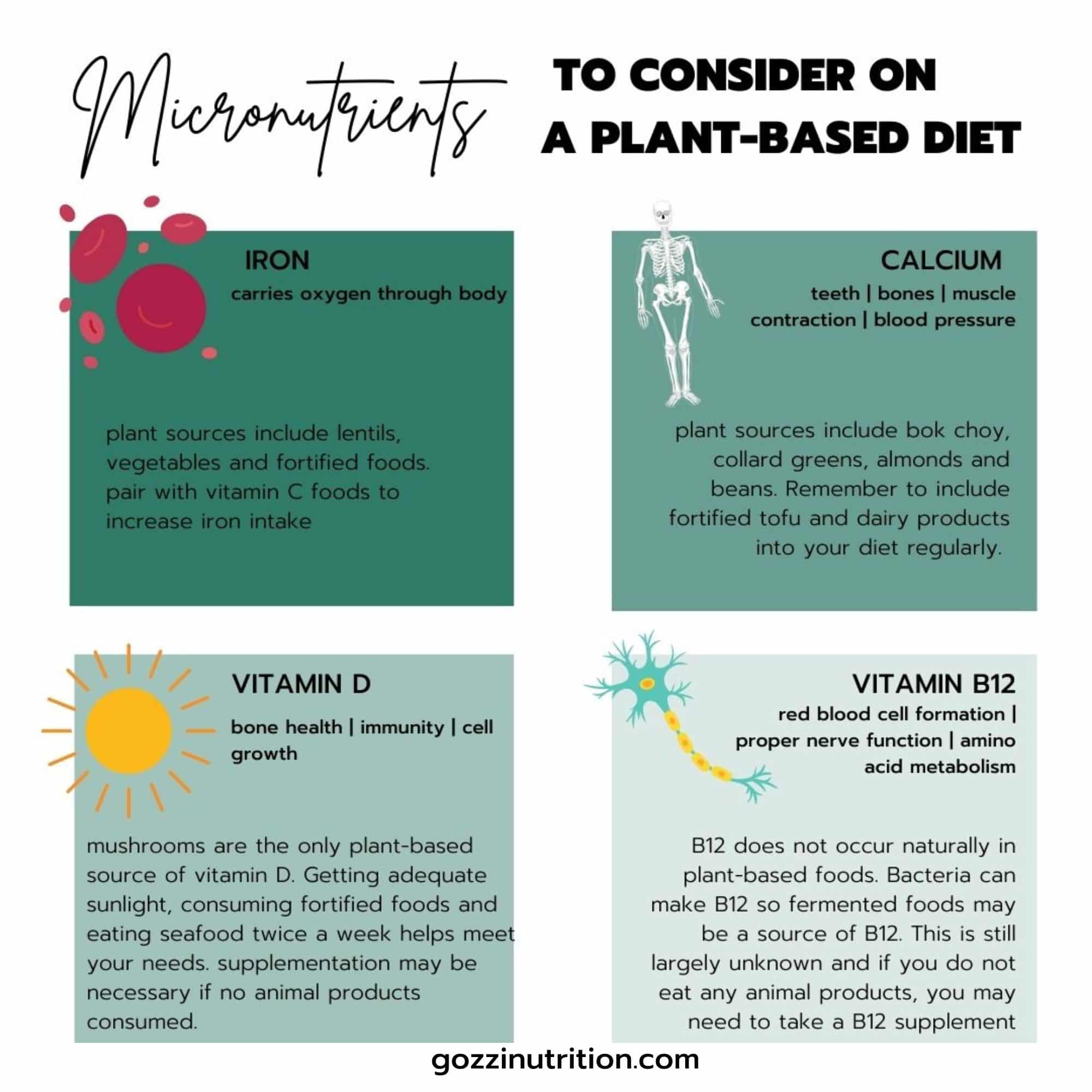
Omega-3 fatty acids
Omega 3 fatty acids are essential nutrients (meaning our bodies cannot make them, we must get them for our diets) that help form the membranes of cells. They also have important anti-inflammatory properties in our bodies (23).
Plant-based sources of omega 3 fatty acids include flax seeds, walnuts, plant oils, chia seeds and algae. The type of omega 3, ALA, found in plant-based foods is not as effective as the types found in fish (EPA and DHA).
If you consume fish on a regular basis (2 times per week) as part of your plant-based diet that includes plant oils and nuts, then this is likely not a concern. Supplements shoulr be considered if you do not. Algae forms of omega-3 supplements are available for vegetarians.
Tips for Eating More Plants
So, if we KNOW that eating more plants is good for us and the planet, why are we not meeting our needs?
Because knowledge does not spur action. We need new menu ideas, strategies for planning healthy meals and understanding how to make food that is both delicious AND healthy.
Basically, you need me! Helping you translate that knowledge about the goodness of plants into plant-powered action is what I was put on Earth to do.
Book a free discovery call with me today to get started. In the meantime, here are my top ten tips for transitioning to a plant-forward diet
Ten ways to simplify the switch to a plant-based diet
Start a plant-forward food journal: record your meals for a week or a month to track your progress and take note of your challenges and successes. Learn more about the food and mood journal method.
Eat more plant-based foods you already like: you may find that you are already eating a lot of plant-based foods or you may be able to make simple swaps to make a meal plant-based.
Understand how to build balanced plant-forward meals. You don’t want to be hungry! Learn how to build a meal balanced with fat, fiber, protein and carbs to keep you full.
Treasure plant-forward and plant-based recipes: building up a good database of recipes or at least plant-based meal ideas will keep things easy in the kitchen
Maintain a well-stocked plant-based pantry: make sure you have plant-based foods on hand so you can whip a quick meal or snack.
Embrace convenience foods: there is no shame in using processed foods like frozen veggies, instant rice and canned beans.
Build a meal plan: I’ll be honest. I don’t love meal planning. But I have a great system that I’ve perfected over the years that I share with my clients.
Learn about plant-based marketing: there’s a lot of buzz words around plant-based foods. Learn what labels matter for your health and which ones are just fluff.
Go gradually: you don’t have to go from steak to tempeh overnight. You don’t even have to abandon steak altogether. Focus on smaller portions of meat, not complete elimination.
Learn to be a better cook: you don’t have to make fancy meals or have expensive tools or a big kitchen to be a good cook. You just need to know how to build flavor and stay organized.
Find a plant-based buddy: if you have a friend or a family member that is interested in eating more plants, consider swapping recipe ideas or sharing cookbooks!
Ok, so I gave you a bonus tip. 🙂

Final thoughts
The plant forward diet is a style of eating that emphasizes plant-based foods like vegetables and fruits, plant-based proteins, whole grains, nuts and seeds, herbs and spices and plant oils without necessarily eliminating animal products.
Plant-forward differs from other plant-based diets because it allows for meat in small quantities relative to plants.
The benefits of a plant-forward diet include improving your overall health, reducing your carbon footprint and enjoying your food.
A plant-forward diet is rich in fiber, vitamins, minerals, antioxidants and protein. People transitioning to a plant-based diet should consider their intake of water, vitamin B12, vitamin D, calcium, iron and omega-3 fatty acids.
Being prepared and taking gradual steps toward your goal will set you up for success when transitioning to a plant-forward diet. I’m here to help as your plant-forward dietitian.
Are you ready to eat less meat and more plants? Unsure where to start?